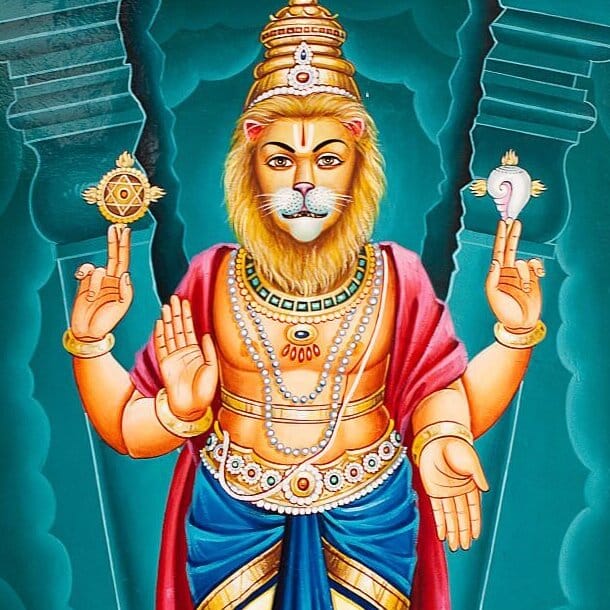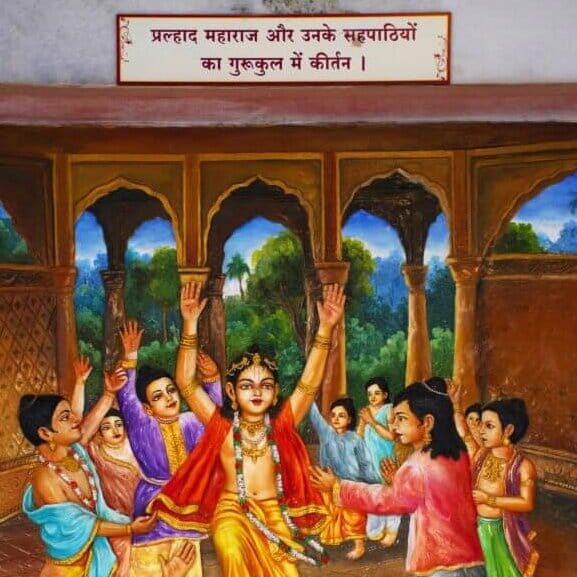Narasimha Jayanti is an important Hindu celebration that honors the fourth incarnation of Lord Vishnu – Lord Narasimha.
Narasimha manifested in a form that is part man and part lion to safeguard his devotee Prahlad and defeat the demon king Hiranyakashipu.
This festival is observed on the Chaturdashi tithi of Shukla Paksha during the Vaishakh month, holding great spiritual significance for followers of Lord Vishnu.
In 2025, Narasimha Jayanti will take place on May 11.
Devotees engage in fasting, perform various rituals, and recite sacred mantras to receive divine blessings, protection, and relief from negative forces in their lives.
Date and Muhurat of Narasimha Jayanti 2025
In 2025, Narasimha Jayanti is celebrated on Sunday, May 11, which corresponds to the Chaturdashi tithi of Shukla Paksha in the month of Vaishakh.
This date commemorates the divine manifestation of Lord Narasimha during the evening hours.
Chaturdashi Tithi Begins: May 10, 2025, at 5:29 PM
Chaturdashi Tithi Ends: May 11, 2025, at 8:01 PM
Evening Puja Muhurat: 4:21 PM to 7:03 PM
Madhyahna Sankalp Time: 10:57 AM to 1:39 PM
Rituals should be performed in the evening (Sandhya Kaal) since it is believed that Lord Narasimha made his appearance during that time.
It is also traditional to take a Sankalp (vow) at midday and maintain a fast throughout the day until the evening puja concludes.

Significance of Narasimha Jayanti
Narasimha Jayanti represents the victory of righteousness over malevolence, divine safeguarding, and the supreme influence of devotion.
According to Hindu texts, Lord Vishnu adopted the formidable Narasimha form to eliminate the oppressive king Hiranyakashipu, who had acquired a boon that rendered him nearly invulnerable.
The Lord emerged from a pillar in his fierce shape — neither fully man nor fully beast — and vanquished the demon at dusk, at the entrance of his palace, thus adhering to all stipulations of the boon.
This incarnation serves as a powerful reminder that the divine will always provide shelter to true devotees, regardless of the severity of their situation.
The story of Prahlad’s steadfast faith amidst challenges inspires countless individuals.
Worshiping Narasimha is thought to remove hindrances, heal ailments, dispel fears, and bestow mental strength, bravery, and divine blessings upon one’s life.
Narasimha Jayanti Vrat Vidhi
The vrat of Narasimha Jayanti is observed with sincere dedication and discipline.
Devotees rise early, take a sacred bath, and make a Sankalp (vow) during midday.
They maintain a fast throughout the day, which can either be nirjala (without water) or phalahar (consisting of fruits and milk only), depending on individual capacity and customs.
In the evening, during the auspicious muhurat, devotees conduct the puja with sincerity.
An idol or image of Lord Narasimha is placed on a clean altar.
Offerings include flowers, turmeric, kumkum, incense, ghee lamps, sweets, fruits, coconuts, and tulsi leaves.
Special bhajans and the Narasimha Stotra are recited.
Prayers aim for protection against fear, illness, adversaries, and negative energies.
After the puja, prasad is shared, and devotees may break their fast after completion of the rituals, ideally after sunset or according to family traditions.
The vrat is regarded as extremely rewarding, providing peace, health, and spiritual advancement.
Puja Samagri
The following items are typically utilized in the Narasimha Jayanti puja:
- An image or idol of Lord Narasimha along with Prahlad.
- Clean water or Ganga Jal.
- A Kalash featuring mango leaves and a coconut.
- Turmeric, Kumkum, and sandalwood paste.
- Akshat, which is unbroken rice.
- Fresh flowers, garlands, and Tulsi leaves.
- Incense sticks and camphor for fragrance.
- Diyas or ghee lamps.
- Sweets such as kheer, laddoos, or coconut-based treats.
- Fruits, including bananas, apples, and mangoes.
- A sacred thread, known as moli.
- Panchamrit, a blend of milk, curd, honey, sugar, and ghee.
The altar needs to be cleaned and adorned.
A serene and spiritually charged environment should be created.
Devotees recite the Narasimha Kavach, Narasimha Stotra, and Vishnu Sahasranama during the rituals to invite blessings and dispel negativity.

Mantras and Stotras for Worship
Reciting mantras and stotras associated with Lord Narasimha amplifies the spiritual impact of worship. Some potent mantras are:
Narasimha Gayatri Mantra:
“Om Ugram Veeram Maha Vishnum Jvalantam Sarvato Mukham
Nrisimham Bhishanam Bhadram Mrityur Mrityum Namamy Aham”
Narasimha Kavach:
This powerful prayer serves as a protective shield against all dangers, evil influences, diseases, and mental strain.
Additionally, the Narasimha Stotra and Vishnu Sahasranama are recited for divine favor and assistance.
Devotees also sing bhajans and hymns that extol Lord Narasimha’s strength and compassion.
These recitations offer mental tranquility, clarity, and fortitude.
Do’s and Don’ts on Narasimha Jayanti
Do’s:
Fast with devotion and make a Sankalp during Madhyahna.
Conduct the evening puja during the designated muhurat.
Chant the Narasimha mantras and read his stories earnestly.
Maintain both cleanliness and spiritual focus all day long.
Present Tulsi leaves during puja, as they are cherished by Lord Vishnu.
Don’ts:
Refrain from eating grains, non-vegetarian food, garlic, and onion.
Avoid engaging in disputes, negative behaviors, or any tamasic acts.
Do not sleep during the daytime; dedicate time to prayer or scripture.
Do not break fast until the evening puja is completed.
Abstain from using disrespectful language or showing disrespect to elders or spiritual topics.
By adhering to these guidelines, devotees can preserve the sanctity of the day and attain the full rewards of their vrat and puja.
Conclusion
Narasimha Jayanti transcends being merely a religious celebration — it serves as a significant reminder of divine justice, protection, and the limitless grace of Lord Vishnu.
Observing this occasion with faith and sincerity aids in overcoming fear, negativity, and life’s hurdles.
Whether confronting external challenges or internal struggles, the worship of Lord Narasimha is thought to provide strength, bravery, and spiritual elevation.
May May 11, 2025, be a blessed day for all devotees to reconnect with their spiritual journey and seek Lord Narasimha’s blessings for peace, prosperity, and divine safeguarding.
Also check: Narasimha Bhagwan aur Prahlad ki katha









